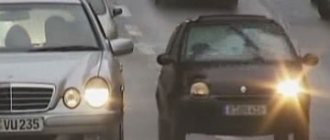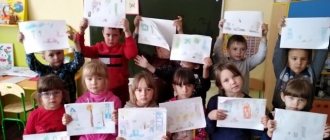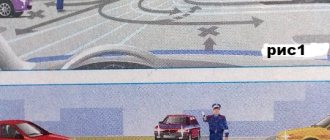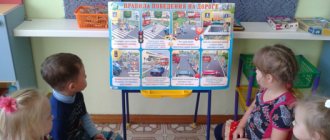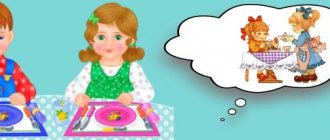Presentation “System of work according to traffic rules” presentation
Slide 1
Building a system of work for preschoolers to study traffic rules Compiled by teacher Oksana Sergeevna Kachaeva
Slide 2
Methods of teaching traffic rules to preschool children The purpose of organizing the work is to form and develop in children the skills and abilities of safe behavior in the surrounding road transport environment. This educational process is quite complex and lengthy, requiring special exercises and the use of a number of didactic methods and techniques. This training system should solve the following tasks: Teaching children safe behavior on roads. Formation in children of skills and abilities to monitor the road situation and anticipate dangerous situations, the ability to avoid them. Fostering discipline and conscious compliance with traffic rules and a culture of behavior in the road transport process. Enrich children's understanding of health. Children need to be taught not only traffic rules, but also safe behavior on the streets, roads, and in transport.
Slide 3
Only through joint efforts, using knowledge, patience and tact, is it possible to: expand children’s understanding of the rules of safe behavior on the streets and roads of the city, in public and private transport through active forms of cognition: design, construction, modeling, artistic and creative activities; teach children to reflect knowledge and ideas about traffic rules in drawings and share their experiences with others; awakening emotional interest in learning traffic rules, improve children’s skills to design, model, combine, draw, sculpt, and create creative compositions on a given topic; cultivating interest in learning traffic rules, developing desires to demonstrate intellectual and constructive abilities, teaching our children the skills of organizing a safe image, intensifying attention, observation, ingenuity, initiative
Slide 4
When building a system of work for preschoolers to learn traffic rules, one should keep in mind three aspects of interaction with the city’s transport system: The child is a pedestrian; The child is a passenger of public transport; A child is a driver of children's vehicles (bicycle, snow scooter, sled, rollerblades, etc.).
Slide 5
Forms of work with children to familiarize themselves with traffic rules Specially organized activities: -creative games; -reading fiction with analysis of the actions of literary characters; -conversations; - role-playing games “Family”, “Transport”, Pedestrians”, “Travelers”; -experimentation and travel games; -individual and subgroup conversations; -storytelling; - problem game and practical situations; -situational tasks; - “Encyclopedia of safe situations”; -books of useful tips; -posters for kids; - dramatization games, travel games; - quizzes, leisure evenings; -project activities; -meetings with people whose professions are related to safety; -thematic competitions, competitions, KVNs; -didactic games Independent activities of children during restricted moments: - examination of illustrations for books; - role-playing games; -drawing on the topic; — didactic games Individual work
Slide 6
Causes of children's road traffic injuries: without looking, they run out onto the roadway because of a standing object; look around casually; without looking back, they begin to move; assess the situation without turning your head; take a step back without looking; react immediately when someone calls them or they see someone; run across the roadway without stopping; they move along the shortest path rather than the safe one; combine movement with conversations, with looking at bright vehicles or toys from another pedestrian; they hold the adult’s hand casually, and sometimes try to break free and run to finish the transition; show indiscipline, push, etc. The behavior of children on the road is influenced by a number of factors, of which it is necessary to emphasize the special importance of the age characteristics of children: 1. A child under 8 years old still does not recognize the source of sounds well and hears only those sounds that are interesting to him. 2. A child’s field of vision is much narrower than that of an adult; a child’s field of view is much smaller. 3. The child’s reaction is significantly slower compared to adults. 4 . Reliable left-right orientation is acquired no earlier than at the age of seven.
Slide 7
Contents of road safety corners in groups In the first junior group, children get acquainted with vehicles: trucks and cars, public transport. Determine what parts the machines consist of. Learn to distinguish between red and green colors. Therefore, the play corner should have a Set of vehicles, Illustrations depicting vehicles, Red and green circles, and a model of a pedestrian traffic light. Attributes for the role-playing game “Transport” (multi-colored steering wheels, hats of different types of cars, badges, vests with the image of a particular type of transport, etc.) Didactic games “Assemble a car” (of 4 parts), “ Put the car in the garage", "Traffic light". In the second junior group, children continue to work on recognizing vehicles, become familiar with the rules of behavior in public transport, consolidate the ability to distinguish between red, yellow, and green colors, and become familiar with the concepts of “sidewalk” and “roadway.” Therefore, to the items available in the road safety corner of the first junior group, you should add: Pictures for the game for classifying modes of transport “What passengers are traveling on”, “Find the same picture”. The simplest layout of a street (preferably large), where the sidewalk and roadway are marked. Layout of a traffic light (planar).
Slide 8
Content of road safety corners in groups For children in the middle group, it will be new to talk about the pedestrian crossing and its purpose, right-hand traffic on the sidewalk and roadway. In addition, children 4-5 years old should clearly understand that when the traffic light turns green for pedestrians and allows them to move, for drivers at that time the red traffic light turns on - prohibiting. When the green light for drivers turns on and allows cars to move, the red light flashes for pedestrians. The road safety corner must have: A model of a traffic light with switching signals, powered by a battery. Didactic games “Find your color”, “Assemble a traffic light” A pedestrian crossing must be marked on the street model. In the older group, children learn a lot of new things about road traffic. It is at this age that one gets acquainted with such large and complex topics as “Crossroads” and “Road signs”. Therefore, in the road safety corner there should be: A mock-up of an intersection, with the help of which children will be able to solve complex logical problems on road safety and practice the skills of safely crossing the roadway at an intersection. It is desirable that this model has removable objects, then the children themselves will be able to model the street. Also, a set of road signs is required, which necessarily includes such road signs as: informational signs - “Pedestrian crossing”, “Underground pedestrian crossing”, “Bus and (or) trolleybus stop”; warning signs – “Children”; prohibitory signs - “Pedestrian traffic is prohibited”, “Bicycle traffic is prohibited”; mandatory signs – “Pedestrian path”, “Bicycle path”; priority signs – “Main road”, “Give way”; service signs – “Hospital”, “Telephone”, “Food station”. • Didactic games: “What do the signs say?”, “Guess the sign”, “Where is the sign hidden?”, “Crossroads”, “Our street” • In addition, for children of the older group they are introduced to the work of a traffic controller. This means that in the traffic police corner there should be diagrams of traffic controller gestures, a didactic game “What does the baton say?”, attributes of a traffic police inspector: baton, cap
Slide 9
Content of road safety corners in groups In the preparatory group, children encounter problematic situations on the roads (so-called road “traps”), children’s knowledge about the Rules of the Road is already systematized. The contents of the corner become more complicated: A file of “dangerous situations” is collected (you can make an improvised TV or computer to display them) A window is organized for issuing driver’s licenses to those who have passed the traffic rules exam. In all groups it is good to have a flannelgraph - for simulating situations on the road, as well as a set of transparencies on various topics.
Slide 10
The corner for parents can be designed like this: 1. A single stand (dimensions depend on the availability of free space and the amount of information placed, but not less than 30*65 cm). 2. A set of components, each of which is designed to contain separate information 3. Folding book To attract the attention of parents when decorating a corner, it is recommended to use bright, attention-grabbing slogans, for example: • “The price of haste is the life of your child” • “Attention - we your children!" • “The child has the right to live!” • “It’s stupid to save your time at the expense of the child’s life”
Slide 11
Considering the important role of parents in teaching children the rules of the road, the corner for parents should contain: 1. Information about the state of road traffic injuries in the city 2. Causes of road accidents involving children 3. Recommendations for parents on teaching children how to behave safely on the road . 4. List and description of games aimed at consolidating children’s existing knowledge of the Rules of the Road 5. Children’s stories about behavior on the road when driving to kindergarten back with their parents
Slide 12
Thus, teaching children the rules and safety of road traffic is a systematic and purposeful process during which students acquire the knowledge, skills and abilities necessary for safe traffic.
Slide 13
People are restless creatures, they are always going somewhere, in a hurry, running, in a hurry. And this is not safe! How can we make our lives safer? You just need to know and be sure to follow all the traffic rules.
MAGAZINE Preschooler.RF
Presentation “We are for road safety”Young pedestrian's corner
The safety corner in kindergarten was created to solve the following problems:
- development in children of the cognitive processes they need for correct and safe orientation on the street;
- teaching preschoolers road vocabulary and involving them in independent creative work, which allows them, in the process of completing tasks, to study and understand the danger and safety of specific actions on the streets and roads;
- developing in children skills and sustainable positive habits of safe behavior on the street.
Lapbook “Traffic Light”:
These manuals are a means of developmental education
Lapbook “Young traffic experts”
Lapbooks are a great help for teachers in working with children. Its use in work allows you to perform certain tasks in almost all educational areas: social and communicative development, speech development, cognitive development, artistic and aesthetic development. Children can also use the material found in lapbooks in independent activities to consolidate their knowledge.
Creative workshop: application on the theme “Traffic light”
Thus, we develop fine motor skills, spatial thinking, imagination, mental and creative abilities.
An interactive whiteboard is also used. With her help we
We watch educational cartoons and conversations. The purpose of which is to develop in children knowledge and skills, practical skills of safe behavior on the road and street.
Albums and books about transport, about rules of behavior on the roads.
They allow children to clarify their knowledge about transport, what we call transport, and what types of transport there are. To generalize and systematize children’s ideas about the methods of human movement in different environments. Clarify and expand children’s understanding of the rules of behavior on the road, continue to familiarize them with the rules of the road, both in class and in their free time.
Viewing the album “Types of Transport” helps your child clarify and expand their knowledge about transport.
A fascinating viewing of the book “Technology and Transport” allows children to clarify the purpose of transport, types of transport and its characteristics in the present, past and future tense.
Didactic games
Such games make it possible to create conditions for activating the mental and cognitive activity of pupils, to reinforce the rules of behavior on the streets, and to develop thinking and intelligence.
Layout "Car Parking"
It includes: posts, sides and ramps for descent and ascent, parking spaces.
Games with miniature cars on a multi-level platform develop children’s ability to clearly and accurately coordinate movements in their hands, which in the future will become a serious incentive for the development of visual-objective and figurative thinking.
| Next > |
